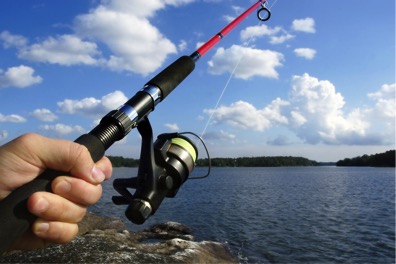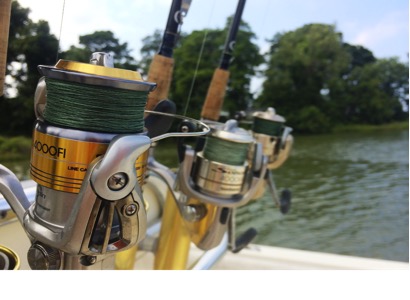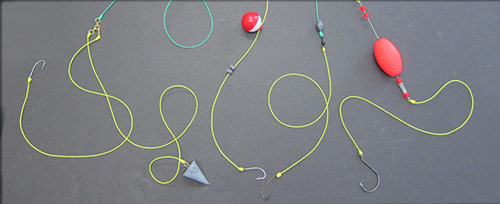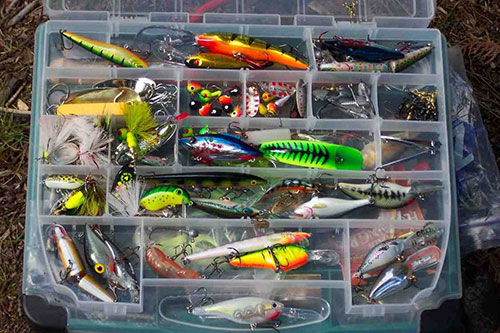Freshwater Fishing Gear
There are all kinds of freshwater fishing gear choices, depending on your experience level, what kind of fish you’re after, and how you’ll be fishing. Selecting your fishing equipment and fishing accessories is part of the fun.

Freshwater Rods
Fishing rods, or poles, are important pieces of fishing equipment. In their simplest form, they are used to throw out a line with a hook on the end for the purpose of catching fish. Learn about different types of fishing rods.
FRESH WATER FISHING RODS: TYPES
Fishing rods vary in width, length and flexibility, depending on where you're fishing and what you're trying to catch. Basically, you want a rod that is stiff enough so it doesn't break when a fish is on your line. But flexible enough to absorb the tension of a fighting fish, so you don't break your line.
Study up. Match the right rod and reel, and the right line and the right bait, and you’re well on your way to catching the fish you're after.
SPINNING RODS
A spinning rod is a style of fishing rod made from graphite or fiberglass with a cork or PVC foam handle. They tend to be between 5 and 8.5 feet (1.5 to 2.6 m) in length. Typically, spinning rods have anywhere from five to eight large diameter guides arranged along the underside of the rod to help control the line. Guides (also known as eyes) decrease in size from the handle to the tip, with the one nearest the handle usually much larger than the rest to allow less friction as the coiled line comes off the reel.
Unlike bait casting and spin casting fishing reels, the spinning reel hangs beneath the rod rather than sitting on top, and is held in place with a sliding or locking reel seat. Spinning rods and reels are widely used in fishing for popular North American sport fish including bass, trout, pike and walleye. Longer spinning rods with elongated grip handles for two-handed casting are frequently employed for saltwater or steelhead and salmon fishing. Spinning rods are also widely used for trolling and still fishing with live bait.
BAIT-CASTING AND CLOSED-SPIN CASTING RODS
Bait-casting and closed-spin casting rods are designed to hold fishing reels that are mounted above the handle. So the line-guide eyes are on the top and the casting trigger is on the bottom.
The rods are made from graphite or fiberglass with a cork or PVC foam handle and tend to be between 5 and 8.5 feet (1.5 to 2.6 m) in length. They have anywhere from five to eight guide eyes to help control the line. The eyes decrease in size from the handle to the tip, with the one nearest the handle usually much larger than the rest to allow less friction as the coiled line comes off the reel.
Longer fishing rods, with elongated grip handles for two-handed casting, are frequently used for saltwater or steelhead and salmon fishing. Spinning rods are also widely used for trolling and still fishing with live bait. Bigger fishing rods are used for bigger bait and bigger fish.
TELESCOPIC FISHING RODS
Telescopic fishing rods are designed to collapse (shorten) or expand (lengthen). 20 - or even 30-foot rods can close to as little as a foot and a half. This makes them very easy to transport.
Telescopic fishing rods are made from the same materials as conventional one- or two-piece rods. Graphite and fiberglass or composites of these materials are designed to slip into each other so that they open and close. The eyes are generally, but not always, a special design to help make the end of each section stronger. Various grade eyes available on conventional rods are also available on telescopic fishing rods.
Be careful about how you open a telescopic rod into the expanded position. Rapidly whipping or flinging open a telescopic fishing rod will likely make it difficult to close. Often the rods come with tip covers to protect the tip and guides.
Carrying around a 12- or 14-foot fishing rod, even in two pieces, may be cumbersome. The shorter the sections, the shorter they close, the more eyes they have, and the better the power curve is in them. More eyes mean better weight and stress distribution throughout the arc. This translates to further casting, stronger fish fighting abilities and less breakage.
FIBERGLASS FISHING RODS
Fiberglass fishing rods work well with crank baits, jerk baits, reaction baits, and baits with treble hooks because the rod flexes and bends, allowing the fish to pull further and the hook to go in deeper.
CARBON-FIBER FISHING RODS
Carbon-fiber fishing rods are commonly used by professionals. They're made with a variety of different qualities of carbon fiber that result in precise casting.
ULTRA-LIGHT FISHING RODS
If you want to catch smaller fish, or get more fight out of a larger fish, then try an ultra-light fishing rod. They're shorter (4 to 5.5 feet is common), lighter and have more flex than normal rods. Tip actions vary from slow to fast, depending on your intended use. Some ultra-light rods are capable of casting lures and flies as light as 1/64th of an ounce.
Ultra-light rods are widely used for crappie, trout, bass, bluegill and other types of panfish.
To learn about different types of freshwater fishing reels visit our next section.
Freshwater Reels

A fishing reel is a mechanical device that holds and spools out fishing line. It has a brake to slow running fish, a handle to retrieve line and a bracket to fasten the fishing reel to the rod.
FRESHWATER FISHING REELS: TYPES
Over the years, hundreds of companies have made thousands of models of fishing reels. But basically there are four types of reels. They vary in size from reels as small as a baseball to giant, sea-fishing reels as big as your head.
BAIT-CASTING REEL
A bait-casting reel is designed to cast larger lures or bait for a longer distance. They typically include a level-wind mechanism to prevent the line from being trapped under itself during rewind and subsequent casts. Many bait-casting reels are also fitted with anti-reverse handles and drags designed to slow runs by large and powerful game fish.
Standard bait-casting reels are mounted above the fishing rod and have a retrieving crank on the right side of the reel. But they're also made for lefties.
Because the momentum of the forward cast must rotate the spool as well as propel the lure, you should always use heavier lures with a bait-casting reel.
OPEN-BAIL SPINNING REEL
With a spin-casting reel, a mechanical pickup is used to retrieve the line and an anti-reverse lever prevents the crank handle from rotating while a fish is pulling line from the spool. And because the line doesn't have to pull against a rotating spool, like it does with a bait-casting reel, you can use much lighter lures with a spin-casting reel.
Fixed-spool reels are cast by opening the bail, grasping the line with the forefinger and then using a backward snap of the fishing rod followed by a forward cast, releasing the line with the forefinger at the same time. On the retrieve, the large rotating wire cage or bail (either manually or trigger-operated) serves as the line pickup, restoring the line to its original position on the spool.
Open-bail reels are traditionally mounted below the rod. And they're really pretty simple to use.
CLOSED SPIN CASTING REEL
As with the open-bail spinning reel, the line on this reel is thrown from a fixed spool, so you can use relatively light lures and baits. However, the closed spin-pin cast reel eliminates the large wire bail and line roller in favor of one or two simple pickup pins and a metal cup to wind the line on the spool. Traditionally mounted above the rod, the spin cast reel is also fitted with an external nose cone that encloses and protects the fixed spool.
Go to the Fly Fishing section for more information on fly fishing reels.
To learn about different types of freshwater fishing hooks visit our next section.
Freshwater Hooks

To find out what kind of fish hook works best for a particular kind of fish or fishing situation, talk to somebody at your local tackle shop. They'll usually describe a hook based on how a particular part of the hook is made.
Over the centuries, fishing hooks have been made of wood, animal and human bone, horn, shells, stone, bronze, and iron. Today, fishing hooks are manufactured from either high-carbon steel, steel alloyed with Vanadium or stainless steel. Hook types can be named after the design of the point, barb, eye, shank, bend or size.
POINTS ON A FISHING HOOK
The point of a fish hook is the sharp end that penetrates the mouth or flesh of a fish. The profile of the fish hook point and its length determine how well the point penetrates.
Point types can be used to describe a certain kind of hook: straight, kerbed (offset to the left), reversed (offset to the right), needle point, rolled-in, hollow, spear, beak, mini-barb, semi-dropped and knife-edge.
BARBS ON FISHING HOOKS
The barb on a fishing hook is the projection extending backwards from the point that keeps the fish from unhooking. The length of the barb determines how much pressure is required to penetrate the point and hold the fish on the hook. In other words, how deep you need to set the hook.
Barbless fishing hooks make hook removal and fish release less stressful on the fish, especially if you're doing catch-and-release fishing.
FISHING HOOK EYES
The eye is the part of the fish hook that's used to connect the hook to the line or lure. Hook eye design is usually optimized for strength, weight and/or presentation.
Fishing hook eye types can be used to describe a certain kind of hook: ring or ball eye, brazed eye (the eye is fully closed), tapered eye (to reduce weight), looped eye (traditional on Atlantic salmon flies), needle eye and spade end (no eye at all, but a flattened area to allow attachment of the leader to the hook).
Fishing hook eyes can also be positioned one of three ways on the shank—up-turned, down-turned, straight, ringed or lopped.
BEND, SHANK AND SHAPE OF FISHING HOOKS
The bend and shank is that portion of the fishing hook that connects the point and the eye. The shape of the hook shank can vary widely from merely straight to all sorts of curves, kinks, bends and offsets. And can contribute to better hook penetration, better fly imitations or better bait-holding ability.
Many fishing hooks intended to hold dead or artificial baits have sliced shanks, which create barbs for better baiting holding ability.
Shank length can be used to describe a certain kind of hook, as in standard, extra-long, 2XL, short, etc. Shape names include Aberdeen, Sproat, Model Perfect, Limerick, Kirby, Carlisle, O'Shaughnessy, Pennell, Eagle Claw and Keel.
FISHING HOOK SIZES
Fishing hook sizes are generally referred to by a number from the smallest (size 32) to the largest (size 19/0). For hook sizes from 32 to 1, the larger the number, the smaller the hook. For fish hook sizes from 1/0 (called a one aught) to 19/0, the larger the number the larger the hook.
FISHING HOOK TYPES AND NAMES
In general, there are three types of fishing hooks: bait-cast hooks, fly-cast hooks and bait and spin-cast lure hooks. But within these broad categories there are countless types of fishing hooks for different species of fish and different fishing methods .
Fishing hooks can be named for their general purpose (bait-cast, fly-cast and bait and spin-cast lure hooks). They can also be named for one or more of their physical characteristics (point, barb, eye, bend, shank and size.) or for a particular species of fish.
Finally, fishing hooks can be named for a combination of characteristics. Truth is, it can get a little confusing. So always ask for a translation.
SINGLE, DOUBLE AND TREBLE FISHING HOOKS
Single fishing hooks have a single eye, shank and point. But the eye, shank, point and bend characteristics can be combined to create hundreds of different hooks for different types of fish and fishing methods. Most sport fish are caught on some sort of single hook, whether it's a hook with bait attached, a hook attached to a lure or hook with a fly.
Double fishing hooks have a single eye merged with two shanks and points. They're formed from a single piece of wire and may or may not have their shanks brazed together for strength. Double hooks are molded into some artificial lures and are a traditional hook for Atlantic salmon flies. Otherwise they're fairly uncommon.
Treble fishing hooks have a single eye merged with three shanks and three evenly spaced points. They're formed by adding a single, eyeless hook to a double hook and brazing all three shanks together. Treble hooks are used on all sorts of artificial lures and for a variety of bait applications.
CIRCLE FISHING HOOKS
These fishing hooks are becoming more popular with catch-and-release anglers. They are designed to result in less damage by hooking the fish in the lip or the corner of the jaw. This makes it easier to unhook and release the fish. With a circle hook, it’s important to let the fish take the bait and turn away before setting the hook. Choose the right size hook to allow room for the bait and the fish lip. And make sure the hook is exposed and not buried in the bait.
TYPICAL FLY FISHING HOOK SHAPES AND NAMES
Typical fly fishing hook shapes include Sproat, Sneck, Limerick, Kendal, Viking, Captain Hamilton, Barleet, Swimming Nymph, Bend Back Model Perfect, Keel and Kink-shank.
There are two basic types of fly hooks. Dry and wet. Fly hooks are also named for insects they simulate (nymph, swimming nymph, scub, pupa, mayfly) or by traditional shapes (Sproat, Sneck, Limerick, Kendal, Viking, Captain Hamilton, Barleet, Bend Back, Model Perfect, Keel, Kink-shank.).
Go to the Fly Fishing section for more information on fly fishing gear.
To learn about different types of freshwater fishing rigs visit our next section.
Freshwater Rigs
A fishing rig is the way you tie together bait, lures, hook, swivels, leaders, sinkers, bobbers, flashers, dodgers, and anything else you can attach to a piece of fishing line. Learn how to create fishing rigs for freshwater fishing.

FRESHWATER FISHING RIGS
Just because you can tie a lot of different things to a line, doesn't mean that making a fishing rig has to be complicated. Most fishing rigs are designed fairly simply and are used for specific fishing techniques
STILL FISHING RIG
Still fishing is an easy way to get started fishing because it’s versatile and can be done when fishing from a pier, a bridge, an anchored boat or from shore. It allows you to fish on the bottom or with your bait suspended above the bottom in ponds, lakes, rivers and streams for a variety of species. Still fish can be done during most seasons and during any part of the day. The fishing rig you use depends on what kind of fish you're after. But the key to still fishing is patience. You have to wait for the fish to bite.
DRIFT FISHING RIG
Drift fishing allows you to fish over a variety of habitats as your boat drifts with the currents or wind movement. You can drift fish on the bottom or change the depth with a bobber or float. Fishing rigs with natural baits work best. But jigs, lures and artificial flies in your drift fishing rig will produce good results too. You can drift fish on ponds, lakes, rivers and streams any time of the day and year.
SLIDING SINKER RIG
For drift fishing, anglers should try the sliding sinker bottom rig. It is a popular, versatile rig and is an effective way to fish bait off the bottom, both from shore and while drifting in a boat. The presentation of the rig allows the sinker to rest on the water bottom with the bait suspended above. This feature prevents the fish from feeling the weight as the line passes through the sinker.
3-WAY RIG
Another rig that works for drift fishing is the 3-way rig (it can also be used when fishing from shore in current). This rig is designed to keep your bait off of the bottom. Both catfish and surf anglers use three-way rigs as well. Pyramid sinkers work well to hold the line in the sand and mud and are often tied to the bottom swivel to anchor bait offerings in tides.
LIVE LINING RIG
Your line is “live” when your boat is anchored in a flowing body of water like a river or stream. Use live or prepared baits in your live lining fishing rig and keep them on or just off the bottom. Live lining fishing rigs allow your line to drift with the current through holes and rocks where the fish may be holding. The fishing rig you choose will depend on what type of fish you’re after.
TROLLING RIG
Most trolling is done using a small electric motor that moves the boat quietly through the water so fish aren't spooked. But you can also troll by towing a fishing rig while walking along the edge of a shoreline, bridge or pier. The speed of the boat determines the depth of your bait. And the depth of the bait on your fishing rig is determined by the species of fish you’re trying to catch. Use a spinning reel or a bait caster for trolling. Some states don’t allow motorized trolling, so check out your local fishing regulations to avoid tangling with enforcement.
BOTTOM BOUNCING FISHING RIG
Bottom Bouncing is done from a drifting or trolling boat, and it’s a great way to attract or locate fish during most seasons and times of day. Use a buck tail jig or natural bait in your bottom bouncing rig and drag it along the bottom. The dragging motion on the fishing rig causes the lure to bounce along, stirring up small clouds of sand or mud. After a few strikes with bottom bouncing, you can drop anchor and apply other fishing rigs to hook the particular kind of species you've attracted.
Freshwater Tackle

FISHING LINE
Fishing line is available in a variety of weights. Most anglers use monofilament nylon fishing line. A good line weight to start with is 6 to 12-pound test. "Pound test" refers to the strength of the line. It's the amount of weight required to break the line. For example, a 10-pound test line is stronger than a 4-pound test line.
The trick is to match the pound test fishing line to the size of your rod and reel, the kind of bait or lure you're using, and the species of fish you want to catch. And that is the key to good fishing.
Using heavier fishing line than necessary may reduce the number of bites or strikes you get because heavy line is more visible in water. And if your line is too light, a bigger fish can break it and take your whole rig. Try explaining that to your buddies.
In fly fishing, fly line is a fairly short length of line made of a plastic coating on a core that is often tapered to make fly casting easier. Backing line is a much longer length of monofilament line with one end attached to the end of the reel spool and the other end tied to the fly line. When you're playing a fish and you run out of fly line, the backing line comes into play. Go to the Fly Fishing Gear section for more information on fly line.
Environmental Alert: To protect wildlife and the environment, always take any discarded line with you when you leave. Discarded line can snag and harm wildlife and kill fish, turtles, frogs, birds and small mammals.
FISHING SINKERS
Fishing sinkers allow you to cast your bait and help take it down to the bottom. Fishing sinkers range in size from split shot – the size of a BB – to weights of a pound or more. BB-size split shot to 1/4-ounce sinkers are most common.
BOBBERS AND FLOATS
Bobbers are used to keep your bait at the depth you want it. They also help you know when you have a strike. Use a bobber that's just large enough to keep your bait from dragging it under the water. Floats, or pencil-style bobbers are more sensitive than round ones, so it's easier to tell if a fish is nibbling at your bait. Round bobbers are easier to cast.
Slip bobbers can be easily adjusted to allow you to fish at different depths. Their main advantage is that they are easy to cast. They come in both round and pencil styles.
Bobbers with direction control allow you to steer your bait or lure and can be more functional at getting to the fish.
Many bobbers attach to your fishing line with a spring clip and move up or down the line easily, depending on how deep you want to fish.
LEADERS
A leader is a length of fishing line (or wire) tied between the end of the line and the lure or hook. Leaders provide extra strength or abrasion resistance from the mouth, teeth, scales, gill covers and tails of fish. It's easier for a fish to snap a single strand of line attached to the hook than it is to snap a line with a leader.
SNAPS
Snaps are small devices similar to a safety pin or a dog leash snap, tied to the line and used for attachment and quick release of hooks, rigs and lures.
SWIVELS
This is a small device with two or more eyes (rings) and a central swiveling part. They're used between a lure or leader and your line to prevent line twisting or tangling from a revolving lure or a barrel-rolling fish.
BAIT SPREADER
Anglers use bait spreaders to separate a lure and a hook or to keep hooks from tangling when using two separate hooks in a rig.
To learn more about Freshwater Bait and Lures visit our next section.